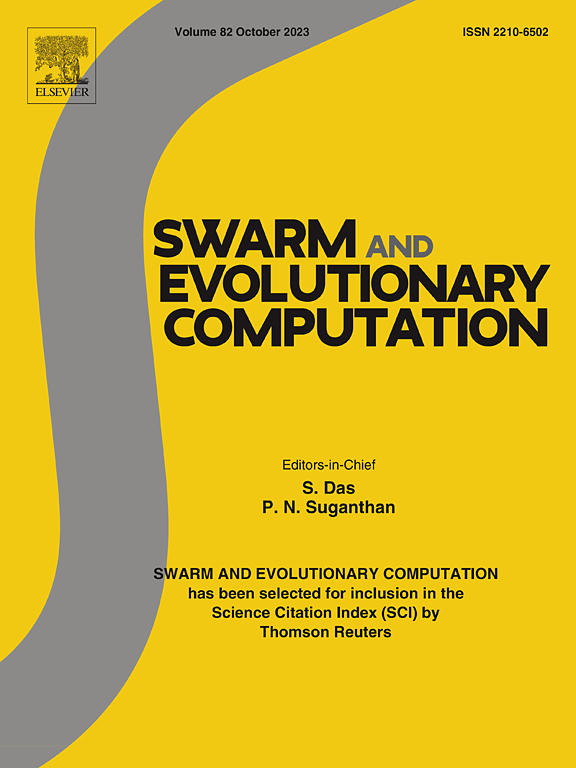A relation learning-assisted algorithm with knee point transfer for expensive dynamic multi-objective optimization
IF 8.5
1区 计算机科学
Q1 COMPUTER SCIENCE, ARTIFICIAL INTELLIGENCE
引用次数: 0
Abstract
Expensive dynamic multi-objective optimization problems (EDMOPs) involve multiple objective functions that change over time steps, and only a limited number of function evaluations are allowed at each time step. Existing methods typically treat EDMOPs as multiple independent static expensive multi-objective optimization problems and track the evolving pareto optimal set (POS) through Gaussian Process (GP)-assisted optimization. However, the dynamic nature of the environment results in a severe scarcity of training samples at each time step, which may impact the fitting accuracy of the GP model and prevent the accurate prediction of the POS. Taking this cue, in this paper, we propose a relation learning-assisted expensive dynamic multi-objective optimization algorithm. Unlike existing methods, the proposed approach simultaneously constructs relation models based on category criteria and fitness criteria. These two types of models work collaboratively in a two-stage filtering mechanism to precisely select the optimized population, enhancing the exploration of the search space while maintaining good fitting accuracy. Additionally, to accelerate the convergence of the optimization process, we predict the knee point set at the current time step using the center points and manifolds of knee points from historical time steps, effectively guiding the search direction of the population. To evaluate the performance of the proposed method, we conduct an extensive empirical study utilizing commonly used EXDMOP benchmarks and a real-world case study on gradient material machining. Experimental results demonstrate the effectiveness of the proposed method in solving EDMOPs.
基于膝点转移的关系学习辅助算法求解昂贵动态多目标优化
昂贵的动态多目标优化问题(EDMOPs)涉及多个随时间步长变化的目标函数,并且每个时间步长只允许有限数量的函数评估。现有方法通常将EDMOPs视为多个独立的静态昂贵多目标优化问题,并通过高斯过程(GP)辅助优化来跟踪演化的pareto最优集(POS)。然而,环境的动态性导致每个时间步的训练样本严重稀缺,这可能会影响GP模型的拟合精度,阻碍POS的准确预测。为此,本文提出了一种关系学习辅助的昂贵动态多目标优化算法。与现有方法不同,该方法基于类别准则和适应度准则同时构建关系模型。这两种模型在两阶段过滤机制中协同工作,精确选择最优种群,在保持良好拟合精度的同时增强了对搜索空间的探索。此外,为了加快优化过程的收敛速度,我们利用历史时间步长的拐点中心点和流形来预测当前时间步长的拐点集,有效地指导种群的搜索方向。为了评估所提出方法的性能,我们利用常用的EXDMOP基准进行了广泛的实证研究,并对梯度材料加工进行了实际案例研究。实验结果证明了该方法求解EDMOPs的有效性。
本文章由计算机程序翻译,如有差异,请以英文原文为准。
求助全文
约1分钟内获得全文
求助全文
来源期刊

Swarm and Evolutionary Computation
COMPUTER SCIENCE, ARTIFICIAL INTELLIGENCEC-COMPUTER SCIENCE, THEORY & METHODS
CiteScore
16.00
自引率
12.00%
发文量
169
期刊介绍:
Swarm and Evolutionary Computation is a pioneering peer-reviewed journal focused on the latest research and advancements in nature-inspired intelligent computation using swarm and evolutionary algorithms. It covers theoretical, experimental, and practical aspects of these paradigms and their hybrids, promoting interdisciplinary research. The journal prioritizes the publication of high-quality, original articles that push the boundaries of evolutionary computation and swarm intelligence. Additionally, it welcomes survey papers on current topics and novel applications. Topics of interest include but are not limited to: Genetic Algorithms, and Genetic Programming, Evolution Strategies, and Evolutionary Programming, Differential Evolution, Artificial Immune Systems, Particle Swarms, Ant Colony, Bacterial Foraging, Artificial Bees, Fireflies Algorithm, Harmony Search, Artificial Life, Digital Organisms, Estimation of Distribution Algorithms, Stochastic Diffusion Search, Quantum Computing, Nano Computing, Membrane Computing, Human-centric Computing, Hybridization of Algorithms, Memetic Computing, Autonomic Computing, Self-organizing systems, Combinatorial, Discrete, Binary, Constrained, Multi-objective, Multi-modal, Dynamic, and Large-scale Optimization.
 求助内容:
求助内容: 应助结果提醒方式:
应助结果提醒方式:


